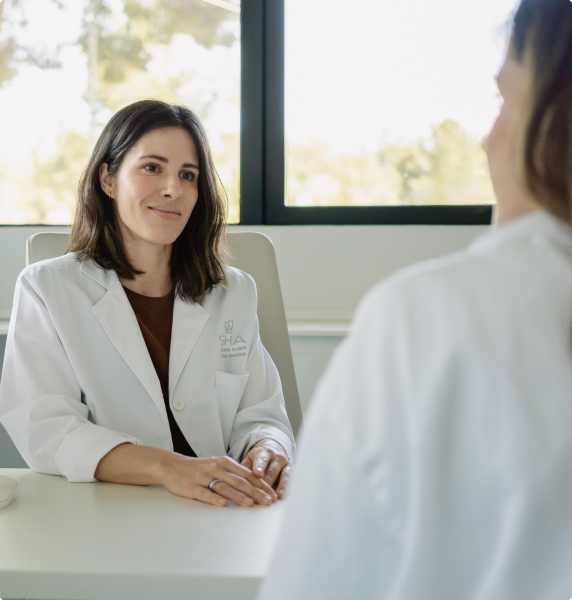Longevity & Functional Medicine
Sexual Well-being
SHA’s Sexual Well-being Unit is focused on achieving sexual well-being from a global and integrative point of view with a multidisciplinary approach
Sexual Well-being Consultation
Clinical evaluation with a specialist in sexual well-being who carries out a comprehensive assessment of the patient’s current situation, including physical, emotional, and psychological aspects. This serves as an initial diagnosis of the state of health and allows specific diagnostic tests and treatments to be recommended depending on each case.

Consultation with a Hormonal Expert
Complete assessment of the neuroendocrine axis that allows the body’s hormonal functioning to be checked, to apply the appropriate treatments as needed and depending on each individual case.

Consultation with a Gynacologist
An assessment of the patient’s medical history and current gynecological situation is carried out. Through a detailed physical examination and questionnaire, key concerns are addressed and personalized recommendations are provided to maintain optimal female health.

Consultation with an Urologist
Consultation with a urology specialist for a review of the patient’s history, as well as a check-up of the current status of their urinary tract. In cases of erectile dysfunction, further detailed studies are carried out, depending on the case, with the performance of various tests or specific treatments, to find personalized solutions.

Diagnostic tests
Blood test
A biochemical study in which the most relevant parameters are measured to determine the current state of health and a complete hormone profile is carried out as a basic diagnostic test for medical consultation with a hormone expert.
Genetic test
Complete genetic study consisting of 3 tests: Oestrogens, Thrombogenes, and Sporadicgenes, whose aim is to detect genetic variants related to estrogen metabolism, estrogen receptors, progesterone, and genes associated with thrombosis or breast cancer, to evaluate possible health risks in the patient.
Transvaginal ultrasound
Examination of the female reproductive system using high-frequency sound waves. The uterus, cervix, and vagina are all carefully scanned.
Mammogram
A high-definition X-ray that uses very low-dose X-rays to diagnose any breast disease.
Treatments
Emfemme
Non-invasive radiofrequency procedure for the treatment of vaginal laxity and sexual dysfunction that provides homogeneous heat throughout the internal or external vaginal area to increase local blood circulation as well as the remodeling of elastin and collagen fibers.
Emsella
A treatment that stimulates the pelvic floor area through deep electromagnetic contractions to improve blood flow to the area and help restore neuromuscular control. Recommended for cases of urinary or fecal incontinence in men and women, erectile dysfunction, or extreme weakness in the pelvic floor.
High Intensity Inductive Therapy
A neuromodulatory treatment using high-density magnetic fields to stimulate nerve cells, musculoskeletal tissue, and blood vessels to produce an anti-inflammatory, analgesic, toning, and tissue regeneration effect.
Female Intimate Rejuvenation
A non-surgical genital rejuvenation treatment with a laser that prevents infections, improves the pelvic floor, and reduces urinary incontinence. It is an advanced technology for a complete recovery of female intimate health.
TIAI Pelvic Floor Health and Sexual Dysfunction Session
Pelvic floor physiotherapy session stimulates nerve cells, musculoskeletal tissue, and blood vessels in this area to treat disorders and sexual dysfunctions in a natural and painless way.
Virile Treatment with Longitudinal Shockwaves
Treatment is used to improve poor erectile function. This technique, although not insensitive, is painless and is performed in various phases (continuous or intermittent) with sessions that last about 15 minutes. Low intensity, radial waves are applied which penetrate (up to 40 mm) directly onto the surface to be treated, causing a tilting micro-trauma that improves circulation and generates blood vessels that did not previously exist. It is only contraindicated in the case of anticoagulant treatment.
Stem cell treatment
This treatment for erectile dysfunction involves the application of stem cells and autologous platelet-rich plasma to the corpora cavernosa of the male member.
You may also be interested in
Healthy Aging
The purpose of this area is to slow down the process of cell degeneration and reactivate the health potential of each individual.
Genomic Medicine
Discovering who we are on a biological level allows us to prevent and avoid possible future illness.
Sleep Medicine
Optimal sleep allows the body to repair itself, while irregular rest leads to fatigue and chronic exhaustion.
Anti-tobacco Medicine
We combine different treatments to stop smoking and avoid situations that may lead to a relapse.
Revitalising Medicine
We restore the balance and functions of altered tissue to recover physical and mental capacities.
Regenerative Medicine
We can prevent disease by regenerating damaged tissue and cells with mechanisms similar to the body’s own.
Dental Health
We care for oral health using advanced techniques to deliver effective results in a single session.
Other Medical Specialities
We give importance to all medical specialities with treatments to boost all the body’s systems.
General Medical Services
We assess the state of health through various medical consultations, diagnostic tests and technologically-advanced treatments.

